- 11 Best Long Planter Boxes to Enhance Your Garden With - January 5, 2024
- Best Bulb Planters That You Should Consider for Your Garden - January 5, 2024
- Best Fiberglass Planters That Will Look Marvelous In Your Home - December 31, 2023
With their showy blooms plus the wide variety of colors that their flowers have, it’s easy to fall in love with hydrangeas. However, the thing is, these plants do have a different set of care requirements so that they can thrive and bloom profusely.
Give your hydrangeas rich and well-draining soil and some fertilizers if necessary. Water it frequently so that the soil doesn’t dry out. Then keep it pest and disease-free. What are the things that you should give your hydrangeas? Even if you’re a beginner, you can keep this plant alive just by following our recommendations from this hydrangea types growing guide.
How to Identify Hydrangeas
Hydrangeas are dicotyledons which means they have two seed leaves. There are around 250 species and close to 20 genera to be found. Each of these plants has its own characteristics, but they do share some attributes that set them apart from other plants.
Probably, the most distinct characteristic is the shape of the fruit, which gives these plants their name. Hydrangea comes from two Latin words:
- Hydor, or water
- Aggeion, or cup or vessel.
As you can guess, the fruits are shaped like a cup or a capsule. Some hydrangeas, however, have fruits that look like berries.
The seeds of hydrangeas often have wings, while the leaves are simple, big, and green. These plants can be deciduous or evergreen, depending on the variety. As such, some hydrangeas keep their color all year round, while others drop their leaves during autumn.
Flowers

Another distinguishing characteristic that most hydrangeas share is the cluster of star-shaped flowers that they have. The flowers are bisexual and contain both the male and female reproductive systems. Most flowers are in shades of:
- Red
- White
- Pink
- Purple
- Blue
Interestingly, some flowers of this plant family change colors depending on the soil’s pH level. For instance, the bigleaf hydrangeas have pink flowers if the soil has a pH of 5.5 or greater. They produce blue flowers for pH levels less than 5.5.
For the most part, hydrangeas are known for their cluster of flowers that can give your garden a dash of color when they bloom. The most well-known hydrangeas are bushes, but one is classified as a vine and can climb trees.
Depending on the variety of hydrangea that you have, these plants may have different characteristics.
Bigleaf Hydrangea
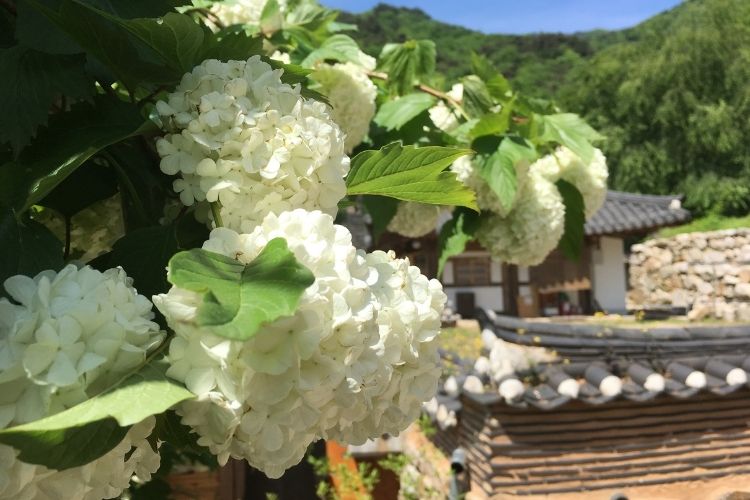
Hydrangea macrophylla, or bigleaf hydrangeas, is also known as florist’s hydrangeas, French hydrangea, or hortensia. This type includes the mophead, mountain, and lacecap hydrangeas.
The mophead has thick leaves that are kind of shiny and can be heart-shaped. These leaves have toothed edges. The flowers are clustered and shaped like pompoms. The lacecap hydrangeas have a flatter cluster of flowers and are only a bit rounded. Meanwhile, mountain hydrangeas have smaller leaves but are more winter-hardy than both the lacecap and mophead types.
Smooth Hydrangeas
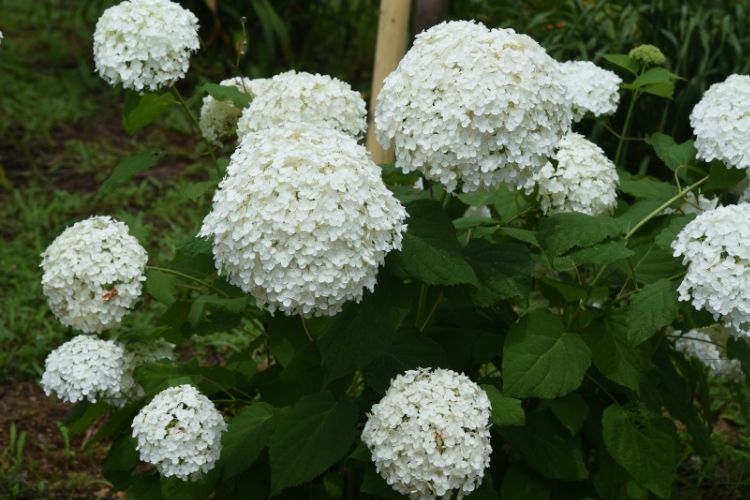
Hydrangea arborescens, or smooth hydrangeas, prefers hotter regions. These plants can be used as hedges because they can grow thick.
Like bigleaf hydrangeas, these plants have heartshaped leaves with a matte finish and coarse texture.
Oakleaf Hydrangeas
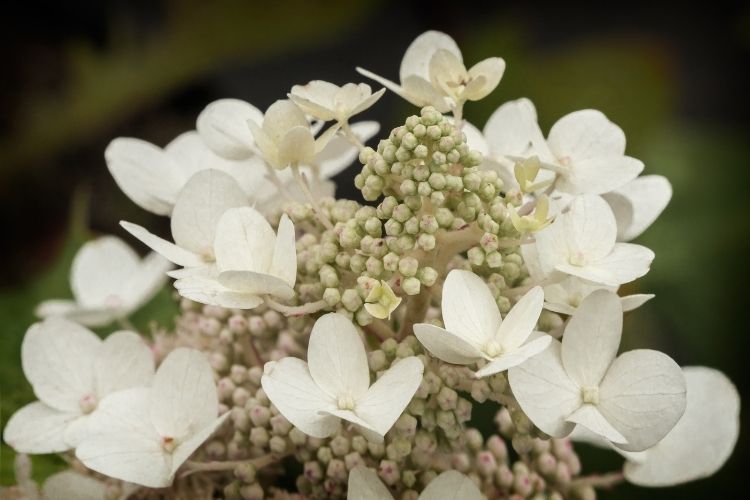
Hydrangea quercifolia, or oakleaf hydrangeas, have leaves that are shaped like a red oak leaf. While these leaves often measure four by four inches (10 by 10 centimeters), they can grow up to 10 inches (25 centimeters) all around.
Oakleaf hydrangeas are great for their fall color, as their leaves change from green to orange and then red and then mahogany. This plant thrives in partly shaded areas.
Panicle Hydrangeas

Panicle hydrangeas, Hydrangea paniculata, have big clusters of flowers that form a cone or pyramid. These flowers often start off as white and then gradually turn pink. The leaves you see on this plant are much thinner and smaller than the leaves of other hydrangeas. Plus, they are rough to the fell. These matte leaves have a medium green hue.
If you live in a region where you get harsh winters, then you should grow panicle hydrangeas. This type is also perfect if you want taller shrubs or trees.
Climbing Hydrangeas
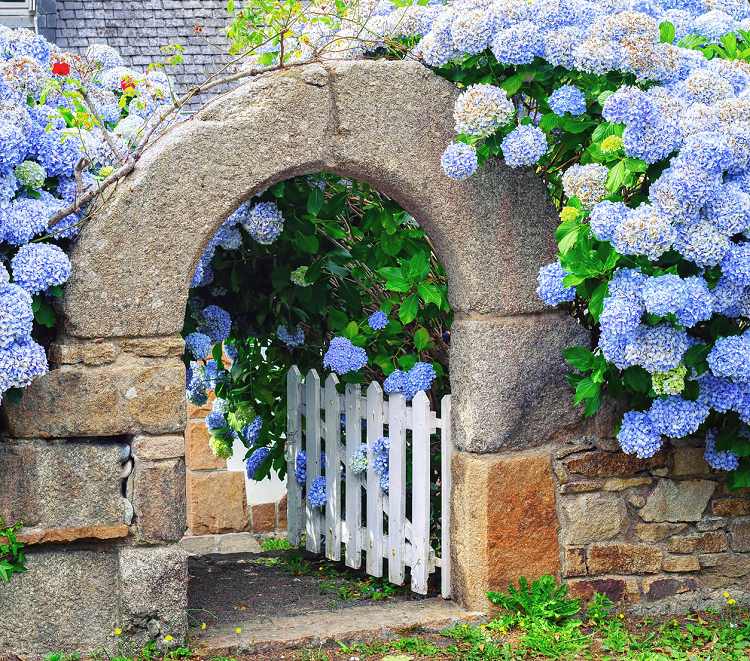
While the first types of hydrangeas we mentioned here are shrubs, the Hydrangea petiolaris is a vine. The climbing hydrangea can creep up trees, walls, or the side of your house. The vines can get up to 30 to 80 feet (9.1 to 24.4 meters) in length.
How to Grow Hydrangeas from Seed
You can grow hydrangea from seed. You will need a pot with soil and then put the seeds on top rather than burying it. To give your hydrangeas a headstart, you can use seed starter mixes, such as:
- Espoma Organic Seed Starter Premium Potting Mix
- Jiffy Natural & Organic Starter Mix
- Sun-Gro Black Gold Seedling Mix
Place the pot near a warm and sunny window, then make sure it’s moist until the first signs of germination show.
The whole germination process should take about two weeks. Once you see the new seedlings, you can plant the hydrangeas in your yard.
How to Propagate Hydrangeas
Propagating hydrangeas is easy. You will need to get a stem cutting and then put it into the soil. If you’d like to somewhat guarantee success, you can:
- Apply rooting hormone to the cut part of the stem cutting.
- Use the softer part of the stem and cut near a leaf node.
- Take away some of the leaves on the stem cutting to prevent moisture loss.
This video will show you just how to do this:
How to Plant Hydrangeas
Planting a hydrangea is best done during the fall, which will allow the plant to bloom in the late spring of the next season. The temperatures are just right, and it will give the new plant some time to develop a strong root system that can survive the colder months of winter.
Planting in the fall will also give the plant enough time to prepare for a whole season of flowers. You can start a hydrangea from seed, or you can buy an already grown shrub.
You might want to buy one gallon or two gallons (7.6 liters) shrub. A hydrangea this big will already have an extensive root system and is easily established. Plus, it’s not too big that you’d need to dig a large hole just to accommodate it.
For your hydrangeas to thrive, you will need to put them in an area that receives full morning sun. Your plant should receive dappled or weak afternoon sun, or it might burn. You will also need well-draining loam soil, which means it has equal amounts of sand, silt, and clay. Hydrangeas grow well in soil that’s rich, but well-draining.
Make sure that you choose a spot that can accommodate a grown hydrangea. Some varieties of this plant can easily grow up to six feet (1.8 meters) wide. When buying a grown hydrangea, always check how big it will get once it reaches maturity.
Digging a Hole
If you have bought a grown plant, you should dig a deep enough hole to level the top of the soil with the ground. You should not set the new plant too high or too low. That’s not much of an issue if you’re transferring seedlings. You can just put the seedlings into the ground.
If you’re planting more than one hydrangea plant, you should give them enough space by growing them two feet (61 meters) away from each other. Having enough space will ensure proper airflow and drive away mildew.
Caring for Your New Plants
For newly planted hydrangeas, you will want to give them a bit of fertilizer. These plants will also enjoy more water when they’re younger.
You will want to give it supplemental water to make sure it grows healthily.
Hydrangeas Growing Conditions
Hydrangeas like well-draining and rich soil. It also prefers a moist environment, so you should plan on watering it often.
These plants will do well when you put them in an area where they can get morning sun and partial shade when the afternoon comes. And if you’re growing these plants outdoors, you will need to protect them from the cold when winter comes.
This means that you should cover your hydrangeas with pine needles, straw, or bark mulch in autumn. You should put about 18 inches of these mulch. These are just the basics. Read on and learn more on how to best care for your hydrangeas and keep them alive.
Hydrangeas Potting & Soil

Soil is probably the most important element in growing healthily blooming hydrangeas. They need to be in well-draining and fertile soil. Keeping your hydrangeas in moist and rich soil will help them thrive. You can add compost to help your plant along, as well as other organic materials.
When it comes to potting, hydrangeas do better when you plant them directly into the ground. But if you want, you can also grow these plants indoors. Just make sure you have the right pot. You can get the smaller varieties of hydrangeas if you have limited space indoors. Dwarf varieties are a good choice.
When it comes to pots, you will want a big planter with a drainage hole. Choose something like these:
- Rivet Rustic Stoneware Crosshatch Indoor Outdoor Flower Plant Pot
- DR.Planzen 10 Inch Plant Pots with Plant Stands
- Modern Round Design Concrete Planter
Hydrangeas Water Requirements
As we have mentioned, your hydrangeas will want more water when it’s young. That holds true for when there is a period of drought.
Generally, hydrangeas like an inch (2.54 centimeters) of water per week when it’s actively growing. The best way to water hydrangeas is to water deeply about three times in a single week so that the moisture goes deeper and the roots will seek out the wetness there.
You should never let your hydrangeas dry out. Bigleaf hydrangeas and smooth hydrangeas will need more water than most other types. However, when you water your hydrangeas, ensure that you don’t get the leaves or flowers wet. Instead, use a soaker hose to deeply water the base.
Another tip? Water in the morning helps your hydrangeas fight the heat and to allows the water to evaporate, which helps prevent diseases. Lastly, organic mulch spread around the base of your hydrangea will help keep the moisture in the soil longer. That’s something that your hydrangeas will really love.
Hydrangeas Light Requirements
Hydrangeas do well when exposed to the morning sun. But these plants may not like the scorching afternoon sun. If the hot afternoon sun is killing your hydrangeas, you can buy something like the Garden Expert 50% Black Shade Net that can help protect your plants from the harsh sunlight.
Conversely, if you put them in an area where they are under full shade, they may not bloom at all. Hydrangeas need around three to six hours of sunlight every day.
Best Hydrangeas Fertilizer
According to The Old Farmer’s Almanac, you may not even need fertilizers if you plant your hydrangeas in rich and fertile soil. But you should perform a soil test to find out if any nutrients are lacking. After that, use a fertilizer that will provide the soil with the nutrients it lacks.
Generally, fertilizing your hydrangeas will encourage the growth of leaves. Having many leaves will mean that the plant will not have enough nutrients and energy to produce flowers.
If you want your hydrangeas to bloom profusely, giving you a lot of nice little bouquets, you can use a fertilizer that encourages flowers such as Flower Fuel 1-34-32. This product boosts your hydrangea’s blooms and gives it a denser and larger cluster.
However, some products can help your plants bloom, such as the EZ-gro Hydrangea Fertilizer, which has aluminum sulfate that encourages blue flowers to bloom and has all the micronutrients your plant needs to thrive.
Best Companion Plantings for Hydrangeas
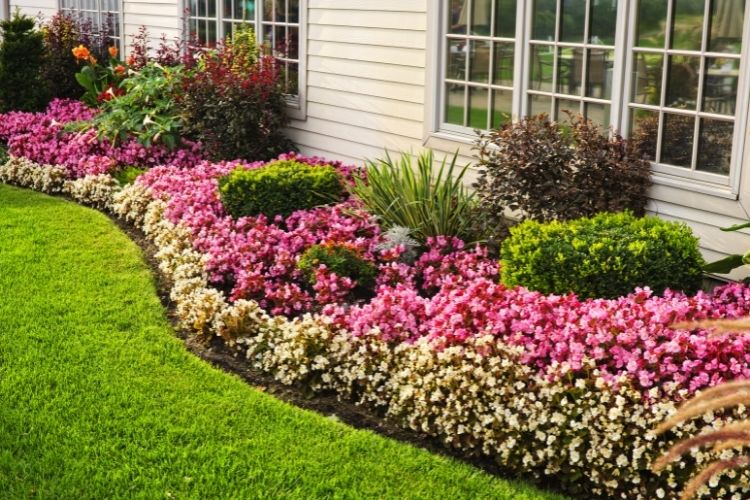
When it comes to companion plants, you have a lot to choose from, and they can look great with your hydrangeas. If you like to cluster different shrubs together, you can start with azaleas. Azaleas put out their flower show early in the season, so the colors pop up early around your garden. After the azaleas bloom, flowers from your hydrangeas will take their place. Other shrubs you can try include:
- Boxwood
- Gardenia
- Hollies
- Loropetalum
- Mahonia
- Yews
Shade-Loving Plants
You can also try perennials such as hostas, foxglove, coral bells, or ferns. Your hydrangeas will protect these plants by casting a shadow over them during the hotter times of the day. Aside from perennials, you should also try annuals such as begonias, coleus, and impatiens. These flowering plants can strike a stark contrast to the big showy blooms that you hydrangeas produce.
Small Trees
Because hydrangeas need protection from the afternoon sun, you should consider planting them in areas where trees can cast shade on them during these times. Try having them near dwarf Japanese maples for that purpose. However, you should be careful not to put hydrangeas where they get no sun at all. Some trees will cast a shadow on your hydrangeas, which may mean that they will not bloom.
Hydrangeas Diseases and Common Problems
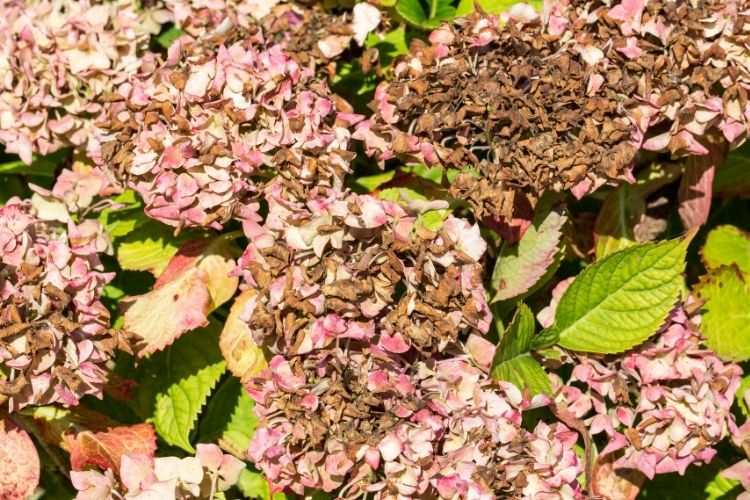
Hydrangeas may be susceptible to several diseases and pathogens, including:
- Powdery mildew, a fungal disease, can be seen on the leaves of your hydrangeas. The white layer contains spores that can infect other parts of your hydrangeas or other plants nearby. This fungal disease can retard the growth of your hydrangeas and may cause them to have fewer blooms.
- Botrytis blight is yet another fungal disease that can get on flower buds. A severe case of blight may even kill the buds before they can open. Blight can also cause reddish-brown lesions on the flowers.
- Leaf spots are lesions on the foliage of your hydrangeas. They start off as small spots but become increasingly bigger and can cause the leaves to wilt and fall off.
- Anthracnose is seen as big brown spots on your hydrangea’s leaves. The flowers may also have a light discoloration at the center.
- Bacterial diseases such as bacterial wilt and bacterial leaf spot can also affect your hydrangeas.
- Viruses are also known to attack hydrangeas, including the ringspot and mosaic virus.
Insects and Pests
The good news is that insects are not that common when it comes to hydrangeas. But when you don’t give your plants the right growing conditions, they can become stressed and more susceptible to red spider mites and aphids infestations.
Hydrangeas Treatments and Maintenance
The good news is that it’s easy to avoid having your hydrangeas fall victim to these pests and diseases. You will need to:
- Prune your hydrangeas. This will help expose the inside portions of your plant to air and sun. Moisture can attract these viruses, bacteria, and fungi to your plant.
- Clean up! Sweep or pick up dead leaves and flowers to keep the fungi away.
- Don’t get the leaves and flowers wet. Water your hydrangeas at the base.
- Act quickly. If you find insects such as aphids on your hydrangeas, get rid of them quickly. Insects can bring these pathogens to your plants.
Pruning Your Hydrangeas
Depending on the hydrangea type that you’re growing, the perfect time to prune your plants is after it flowers or in late winter. To make it easier to know when to prune the particular hydrangea you have, remember these:
- Prune your bigleaf, oakleaf, mountain, and climbing hydrangeas in the summer after the plant flowers. The new buds will appear on old growth.
- Prune your panicle and smooth hydrangeas in late winter. This pruning allows the plant to grow the flowers on new growth when spring comes along.
That’s the general rule. There are other things you should remember. When pruning your bigleaf, oakleaf, mountain, and climbing hydrangeas,
- Prune before August comes in. The buds will form in the late summer and will only open in the next season.
- Do not cut away anything but deadwood when you prune in the fall right through spring.
- Prune the oldest stems of your hydrangea down to the base. This will urge your plant to branch out and become fuller.
- If you want to rejuvenate your hydrangeas, you should prune all the stems to the base to help save an old, damaged or neglected plant.
When pruning your panicle and smooth hydrangeas,
- Prune only when the plant is dormant, which is in late winter. The flower buds are dead because of the cold, and pruning will urge the plant to produce new ones when spring rolls in.
- Cut only the deadwood. You should not cut your hydrangea to shape it.
Where to Buy Hydrangeas Seeds Online
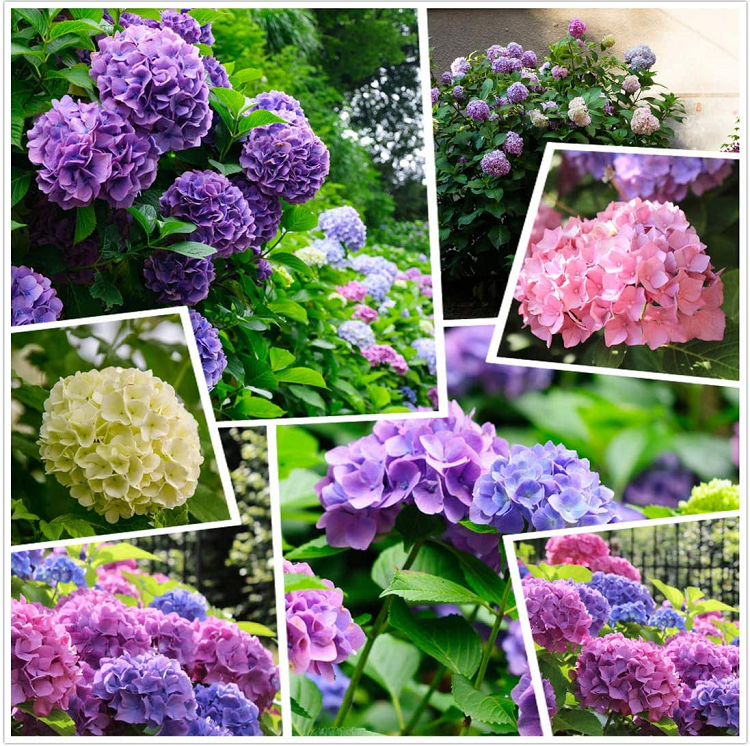
You can buy seeds for several hydrangea varieties from Amazon, including this mixed color package of 50 seeds. And if it’s on Amazon, you can also probably find it on Etsy. You can also check out Green Seed Garden for more types of hydrangeas that you can plant. Other online retailers, you should check out include:
Where to Buy Mature Hydrangeas Online
If you’re impatient and would like to buy a live hydrangea shrub instead of waiting for the seeds to grow, you can head on to your local garden centers. Or you can just order one from the online sites of your favorite big-box retailer.
For example, Home Depot has an extensive selection of hydrangeas for sale. Other online retailers that can ship you a live hydrangea plant includes:
FAQs
Answer: When you gauge if you need to water your plants, you should stick a finger into the soil. Go as deep as one inch (2.54 inches) or just past the first knuckle. If the soil isn’t moist, it’s time to get the garden hose out. If you haven’t had rain for quite a while, you should be watering your hydrangeas in a day or two. Or a better way is to get a product such as apine Soil Moisture Meter.
This soil moisture meter can detect how moist or dry the soil is without having to guess or get your hands dirty.
Answer: Hydrangeas have blue flowers when the soil is acidic and pink blooms when the soil is alkaline. While not technically a fertilizer, you can add garden lime to the soil for those pink blooms. Get products like Jobe’s Organics Garden Lime Soil Amendment for pink flowers on your hydrangea. Garden lime also helps your plants absorb the nutrients from the soil.
Answer: You can use the blooms of your hydrangeas to create eye-catching wreaths or use them as decoration around your home. You will need to wait until the flowers are already mature and have a consistency similar to paper. Cut the flower heads, leaving just enough stem for you to be able to use it for whatever it is you’re making. Remove the leaves, and then just hang the cut flowers upside down inside an airy, dark, dry, and warm room.
Make sure that you don’t put the cut flower heads under direct sunlight. If you want to enhance its color, you can spray diluted fabric dye on the dry flowers.
Grow the Healthiest Hydrangeas You Can Find
Hydrangeas are easy to care for and are basically low maintenance. However, you should make sure that it grows on good soil, watered frequently, and pruned so that it thrives.
Hydrangea Types Growing Guide: Research Citations
- DIY Network: Types of Hydrangea
- Gardener’s Path: HOW TO IDENTIFY AND TREAT HYDRANGEA DISEASES
- Gilmour: Growing and Caring for Beautiful Hydrangea Flowers
- Martha Stewart: How to Plant Hydrangeas
- Plant Addicts: Hydrangea Companion Plants
- SFGate Home Guides: Characteristics of the Hydrangeaceae Plant Family
- The Old Farmer’s Almanac: GROWING HYDRANGEAS
- YouTube: Propagating Hydrangea Cuttings the Easy Way

